Table of Contents
- Introduction
- Editor’s Choice
- Digital Workplace Market Statistics
- Adoption of Digital Technologies in the Workplace Statistics
- Commonly Adopted AI Use Cases in the Workplace
- Top Company Initiatives for Digital Workplace Statistics
- Digital Transformation Spending Statistics
- Benefits of Adopting a Digital Model
- Digital Workplace Trends
- Recent Developments
- Conclusion
- FAQs
Introduction
Digital Workplace Statistics: The digital workplace transforms contemporary business by integrating digital technologies and collaborative tools.
Its adoption brings benefits like improved collaboration and productivity, especially in the context of remote work trends.
Factors driving this shift include the need for operational agility and advanced technologies such as cloud computing and artificial intelligence. Despite its advantages, challenges like cybersecurity threats and employee resistance need attention.
Looking forward, the digital workplace’s future involves ongoing innovation with augmented reality and advanced analytics.
In summary, it is a vital aspect of modern business strategies, enhancing efficiency and connectivity while requiring strategic adaptation to workforce needs.
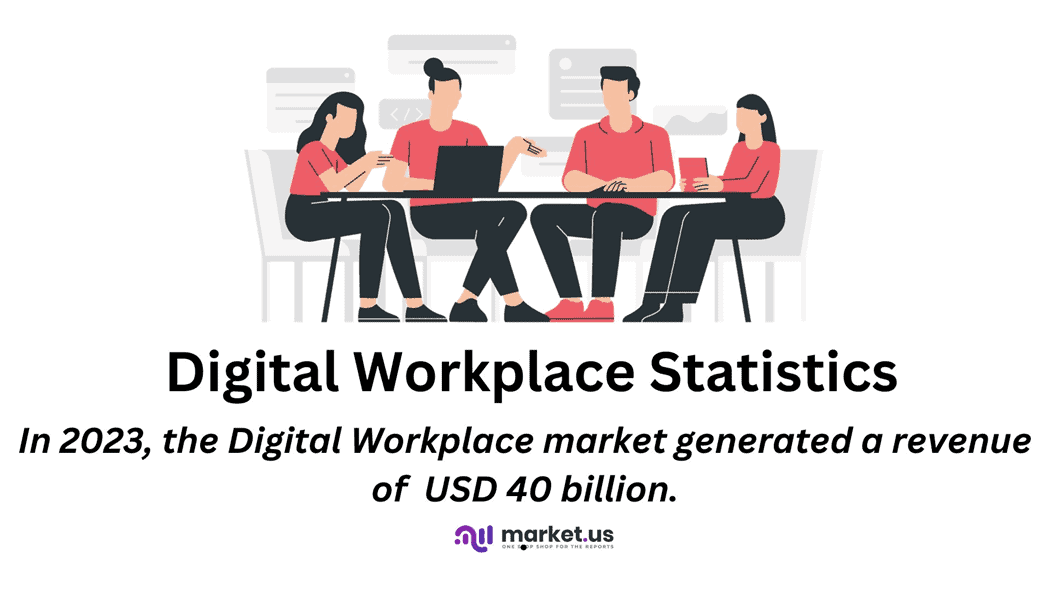
Editor’s Choice
- The digital workplace market is poised for substantial growth at a CAGR of 22.3%.
- The digital workplace market revenue reached USD 40.0 billion in 2023.
- The Information Technology and Telecommunications (IT & Telecom) sector dominates with a substantial 24% share. Underscoring its pivotal role in driving digital workplace advancements.
- Notably, traditional web technologies exhibit a high adoption rate, with 85% of respondents from companies with successful transformations and 85% of all other respondents actively incorporating them.
- Among the commonly adopted AI use cases, service operations optimization leads with 24%. Emphasizing the commitment to refining and streamlining internal processes.
- Notably, digital transformation emerges as the leading initiative, with 54% in 2020 and a slight increase to 56% in 2021. Underscoring a persistent commitment to evolving and modernizing organizational processes.
- The spending on digital transformation technologies and services is expected to reach USD 2.92 trillion in 2025 and further expand to USD 3.4 trillion by the year 2026.
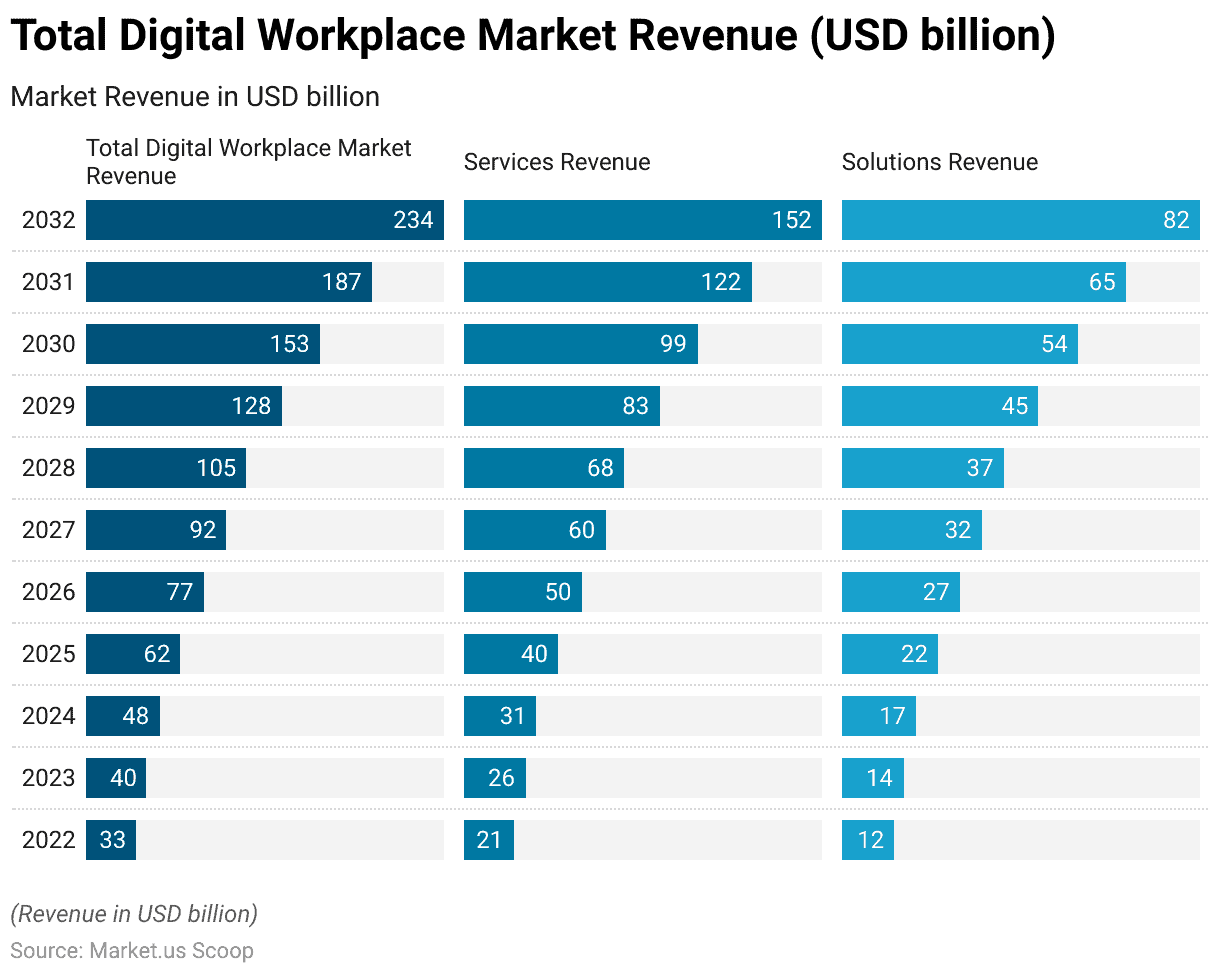
Digital Workplace Market Statistics
Global Digital Workplace Market Size Statistics
- The digital workplace market is poised for substantial growth at a CAGR of 22.3%. As evidenced by the projected revenue figures over the next decade.
- In 2022, the market generated USD 33.0 billion, marking the starting point for a robust upward trajectory.
- Steadily climbing, the revenue is anticipated to reach USD 40.0 billion in 2023 and further escalate to USD 48.0 billion in 2024.
- The momentum continues with notable increments in subsequent years, with projected revenues of USD 62.0 billion in 2025, USD 77.0 billion in 2026, and USD 92.0 billion in 2027.
- The upward trajectory persists, reaching USD 105.0 billion in 2028 and soaring to USD 128.0 billion in 2029.
- As we progress into the next decade, the digital workplace market is expected to attain revenues of USD 153.0 billion in 2030, USD 187.0 billion in 2031, and a substantial USD 234.0 billion in 2032.
- This trajectory signifies a promising landscape for stakeholders. Underlining the market’s significant potential for expansion and economic impact in the coming years.
(Source: Market.us)
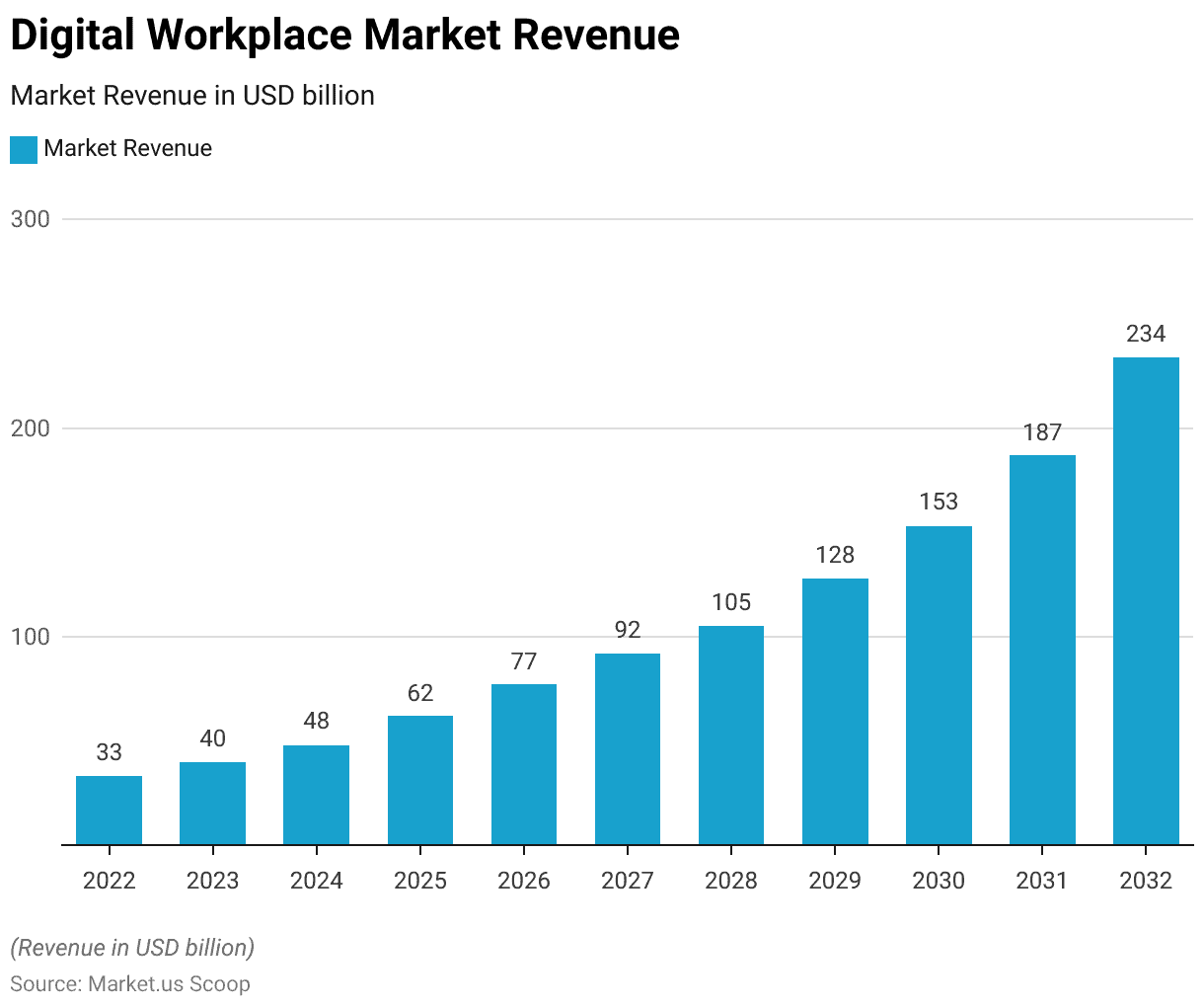
Global Digital Workplace Market Size – By Component Statistics
- The global digital workplace market is poised for substantial growth over the coming years. As evidenced by the projected revenue figures.
- In 2022, the total market revenue is estimated at USD 33.0 billion, with services contributing USD 21 billion and solutions generating USD 12 billion.
- This upward trajectory is expected to persist, reaching USD 40.0 billion in 2023, USD 48.0 billion in 2024, and further escalating to USD 62.0 billion in 2025.
- This trend is expected to intensify, with the market size forecasted to reach USD 234.0 billion by 2032. The progression is marked by consistent increments in both services and solutions revenues.
- By 2030, the market is anticipated to hit USD 153.0 billion, with services accounting for USD 99 billion and solutions reaching USD 54 billion.
- The growth of the market can be attributed to the increasing demand for digital transformation across industries. Driving the adoption of comprehensive digital workplace solutions and services.
- The services sector, encompassing tailored consulting and support, is set to play a pivotal role, with revenues projected to reach USD 122 billion in 2031 and USD 152 billion in 2032.
- This optimistic trajectory underscores the industry’s resilience and adaptability, aligning with the prevailing trend toward digitalization and advanced workplace technologies.
(Source: Market.us)
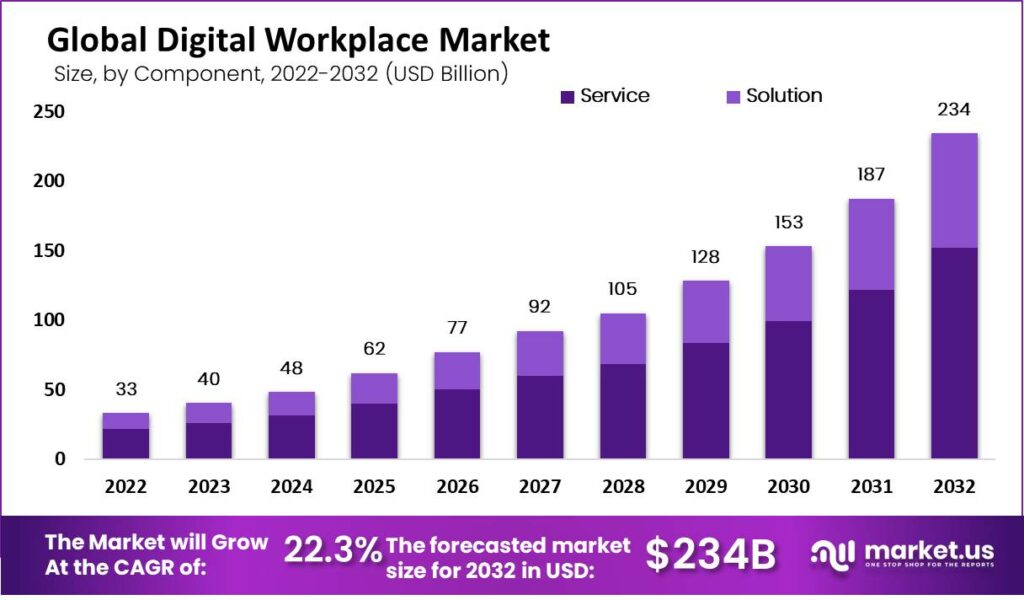
Global Digital Workplace Market Share – By End-user Statistics
- In the global digital workplace landscape, the distribution of market share among various end-user sectors reveals distinct patterns.
- The Information Technology and Telecommunications (IT & Telecom) sector dominates with a substantial 24% share. Underscoring its pivotal role in driving digital workplace advancements.
- Following closely, the Retail sector commands a noteworthy 19%, signifying its embrace of digital transformation.
- Healthcare claims a significant 17% share, reflecting the sector’s increasing integration of digital solutions.
- Meanwhile, the Banking, Financial Services, and Insurance (BFSI) sector and Government entities each contribute 10%. Showcasing their commitment to digital workplace strategies.
- The Media and entertainment industry follows with an 8% share, emphasizing its growing reliance on digital technologies.
- Other end-users collectively account for 12%, illustrating a diverse range of sectors participating in the digital workplace evolution.
- This comprehensive breakdown elucidates the dynamic landscape of the global digital workplace market. Highlighting the varied adoption rates across key end-user segments.
(Source: Market.us)
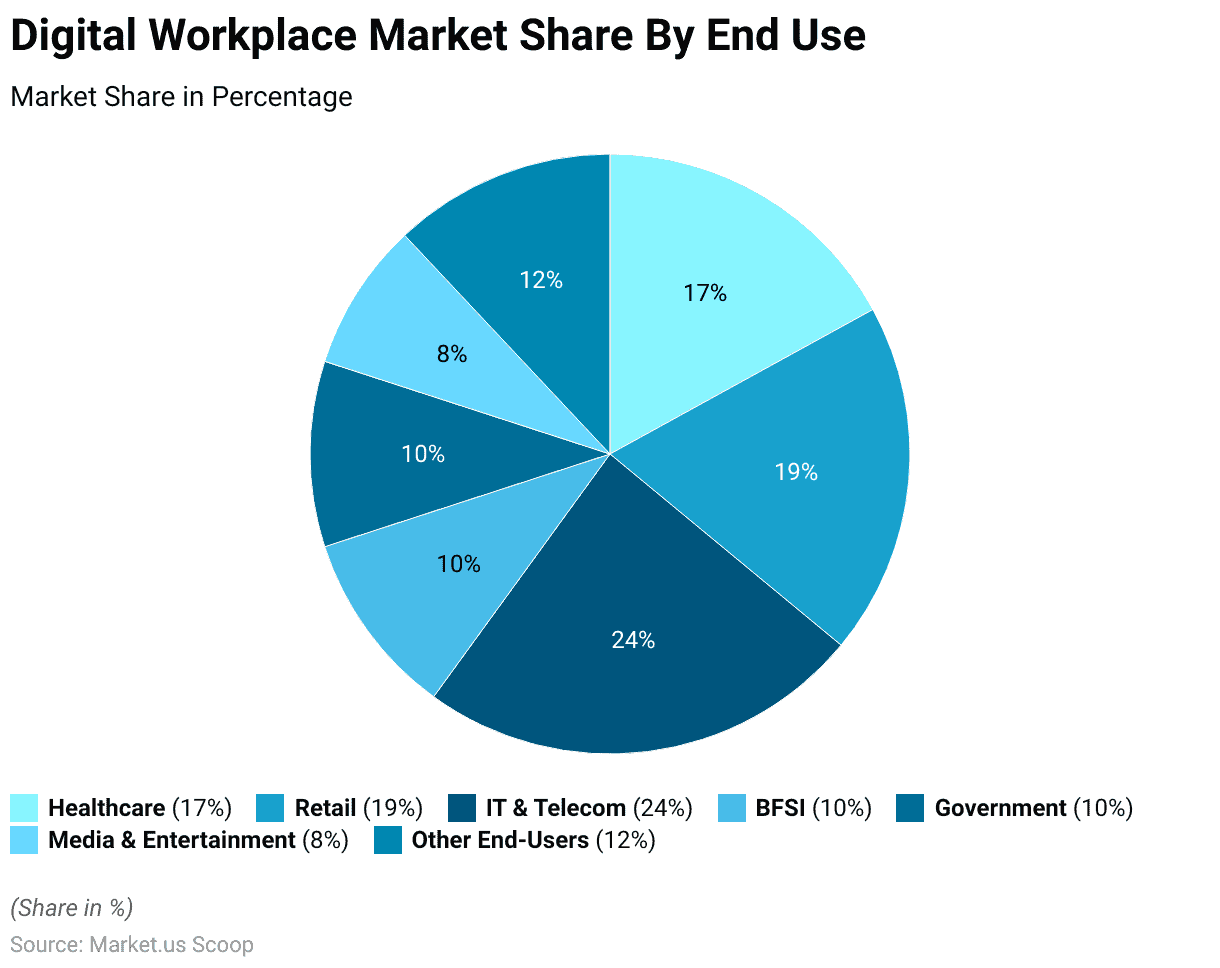
Adoption of Digital Technologies in the Workplace Statistics
- The adoption of digital technologies in the workplace varies across different technologies and activities, as indicated by the survey responses.
- Notably, traditional web technologies exhibit a high adoption rate, with 85% of respondents from companies with successful transformations and 85% of all other respondents actively incorporating them.
- Cloud-based services also demonstrate widespread integration, with 81% of respondents from successful transformation companies and 71% from others utilizing these services.
- Mobile internet technologies follow closely, with 68% and 53% adoption rates, respectively.
- Big data and its architectural components, such as data lakes. To see adoption by 56% of successful transformation companies and 50% of others.
- The Internet of Things (IoT) has a 45% adoption rate among successful transformation companies and 33% among others.
- Design thinking is embraced by 44% and 34%, respectively.
- As the complexity of technologies increases, the adoption rates taper off, with artificial intelligence tools at 31% and 23%. Robotics at 21% and 24%, and advanced neural machine learning techniques at 17% and 11%.
- Augmented reality technologies and additive manufacturing, such as 3D printing. Exhibit lower but still notable adoption rates of 15% 12%, and 13% and 12%, respectively.
- This nuanced analysis underscores the varied pace of adoption across diverse digital technologies within the workplace.
(Source: Mckinsey)
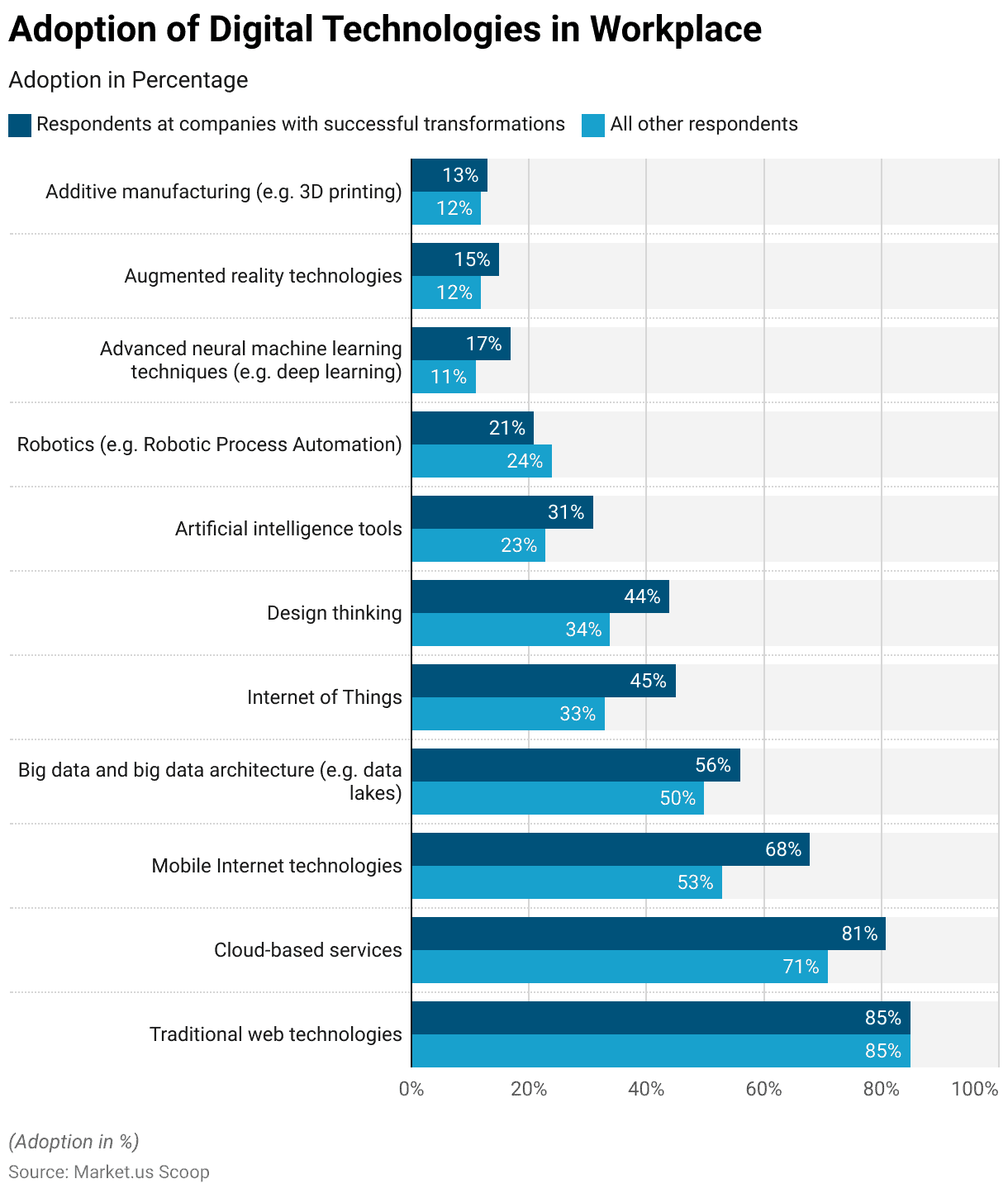
Commonly Adopted AI Use Cases in the Workplace
- In the workplace, the adoption of artificial intelligence (AI) is evident across various use cases. Reflecting a strategic integration of advanced technologies to enhance operational efficiency and business outcomes.
- Among the commonly adopted AI use cases, service operations optimization leads with 24%. Emphasizing the commitment to refining and streamlining internal processes.
- The creation of new AI-based products closely follows, representing a significant 20% adoption rate. Showcasing the integration of AI in product innovation and development.
- Customer service analytics, customer segmentation, and the incorporation of new AI-based enhancements for products each hold a notable 19%. Underlining the pivotal role of AI in refining customer-centric strategies and product offerings.
- Customer acquisition and lead generation follow closely at 17%, reflecting the application of AI in driving marketing and sales initiatives.
- Other prominent use cases include contact center automation and product feature optimization, both standing at 16%.
- Additionally, risk modeling and analytics, as well as predictive service and intervention, demonstrate a 15% and 14% adoption rate, respectively. Indicating the deployment of AI in strategic decision-making and proactive service approaches.
- This comprehensive adoption of AI across diverse workplace applications underscores the versatility and transformative impact of artificial intelligence in shaping contemporary business practices.
(Source: Mckinsey)
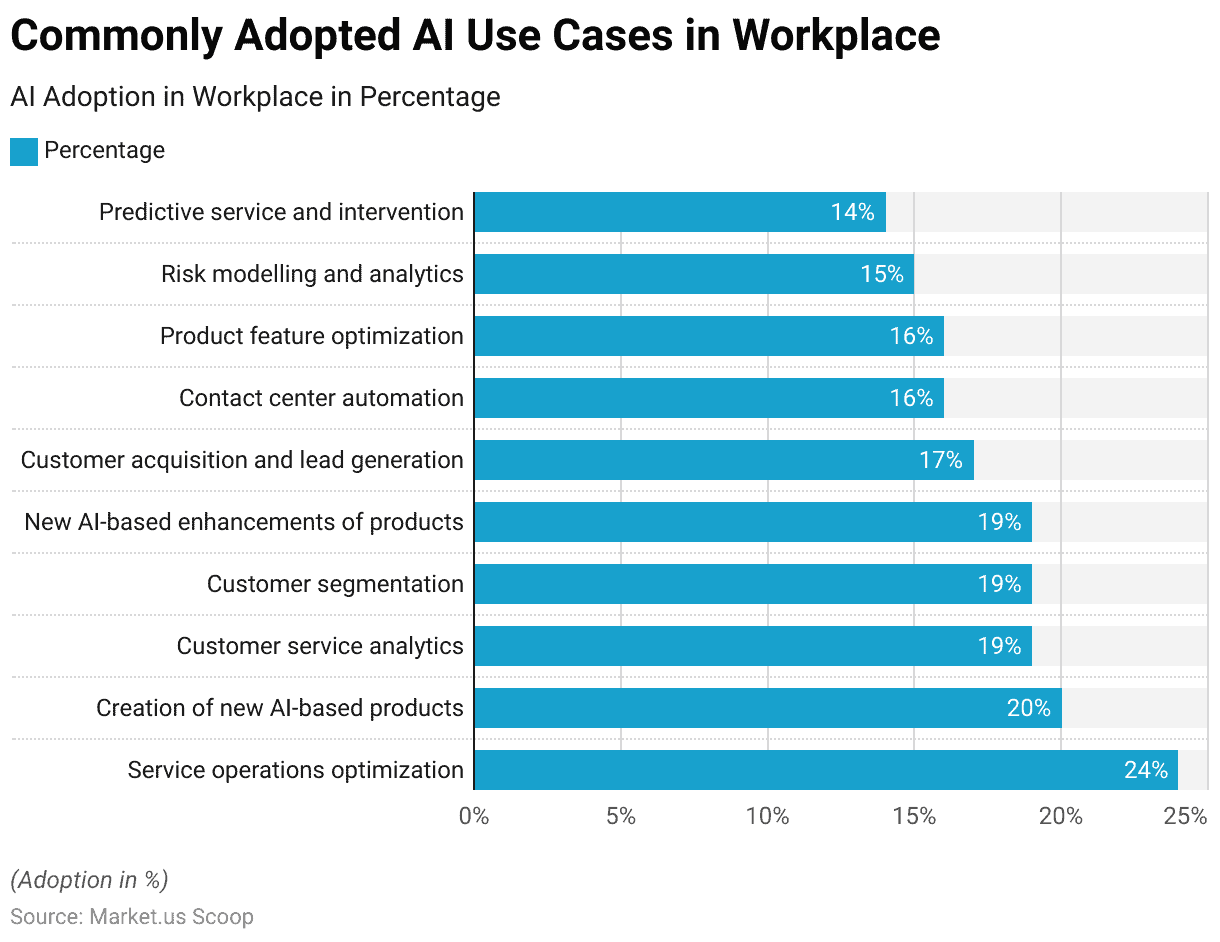
Top Company Initiatives for Digital Workplace Statistics
- In the realm of digital workplaces, companies are actively prioritizing key initiatives to stay competitive and resilient.
- Notably, digital transformation emerges as the leading initiative, with 54% in 2020 and a slight increase to 56% in 2021. Underscoring a persistent commitment to evolving and modernizing organizational processes.
- Cybersecurity remains a significant focus, with 49% and 50% in 2020 and 2021, respectively. Highlighting the continued emphasis on safeguarding digital assets and data.
- Cloud migration experiences a notable surge, jumping from 40% in 2020 to 48% in 2021. Indicative of a growing recognition of the benefits of cloud infrastructure in enhancing flexibility and scalability.
- Customer experience, while slightly diminishing from 37% to 29%, continues to be a substantial area of concentration. Emphasizing the importance of delivering seamless and user-centric interactions.
- Furthermore, cost savings witness a substantial increase from 9% in 2020 to 27% in 2021. Reflecting a heightened awareness of the financial advantages associated with digital workplace initiatives.
- Automation and analytics initiatives, however, experience a slight decline from 17% to 12% each. Suggesting a nuanced shift in strategic priorities.
- Overall, these trends highlight a dynamic landscape where companies are strategically aligning their digital workplace initiatives to navigate the evolving business environment effectively.
(Source: Technology Magazine)
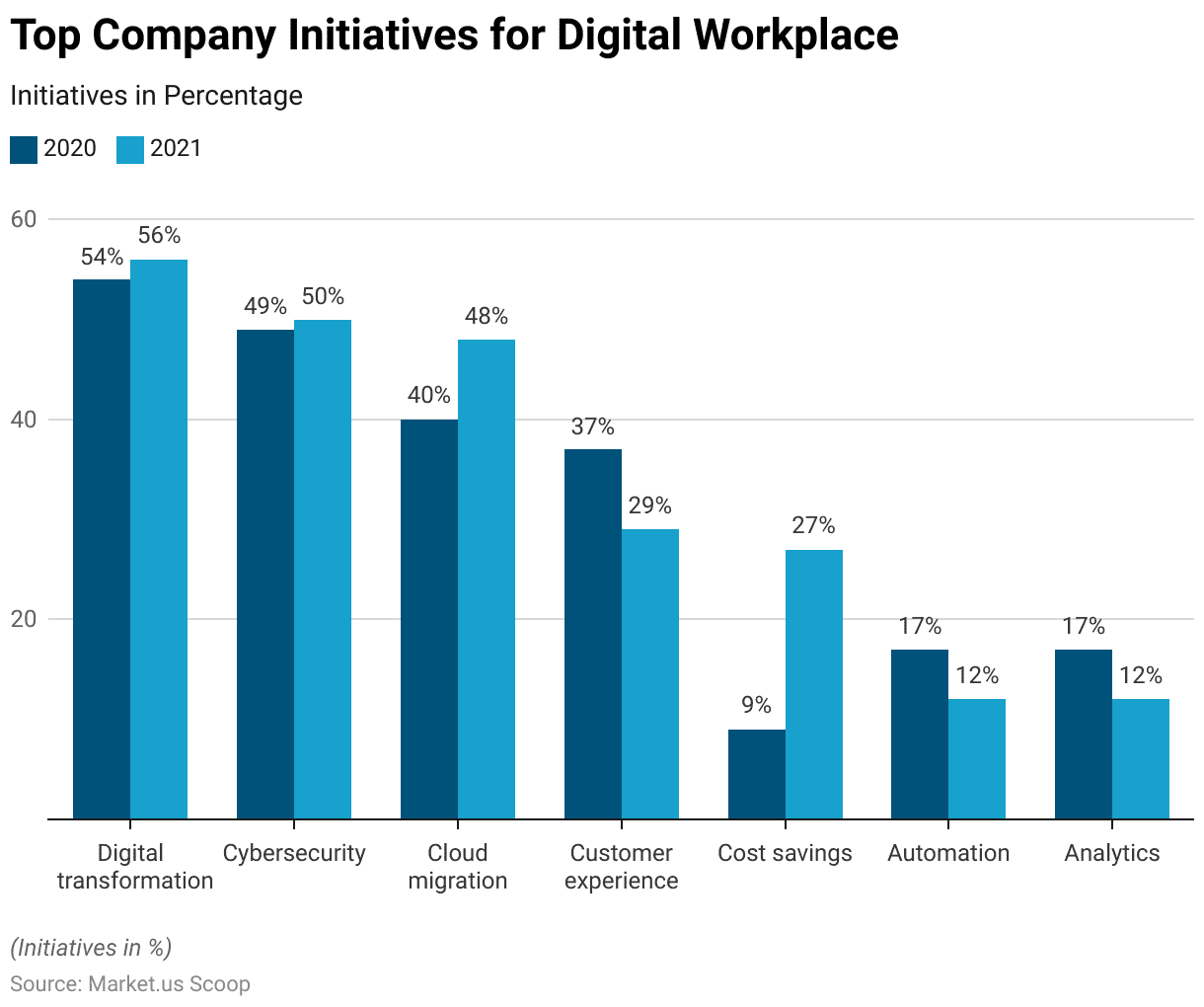
Digital Transformation Spending Statistics
- The global landscape for digital transformation technologies and services has witnessed a steady and substantial increase in spending over the years.
- In 2017, the expenditure stood at USD 0.96 trillion, reflecting an initial commitment to embracing digital transformations.
- This investment trend continued to grow, reaching USD 1 trillion in 2018 and further escalating to USD 1.18 trillion in 2019.
- Notably, the year 2020 saw a significant surge in spending, totaling USD 1.31 trillion. As organizations accelerate their digital initiatives in response to changing market dynamics.
- The momentum continued into 2021, with spending increasing to USD 1.59 trillion.
- Projections for the coming years indicate a continued upward trajectory, with anticipated expenditures of USD 1.85 trillion in 2022, USD 2.16 trillion in 2023, and USD 2.51 trillion in 2024.
- Looking further ahead, the spending on digital transformation technologies and services is expected to reach USD 2.92 trillion in 2025 and further expand to USD 3.4 trillion by the year 2026.
- This evolving investment pattern reflects the growing recognition of the pivotal role played by digital transformation in shaping the future landscape of various industries.
(Source: Statista)
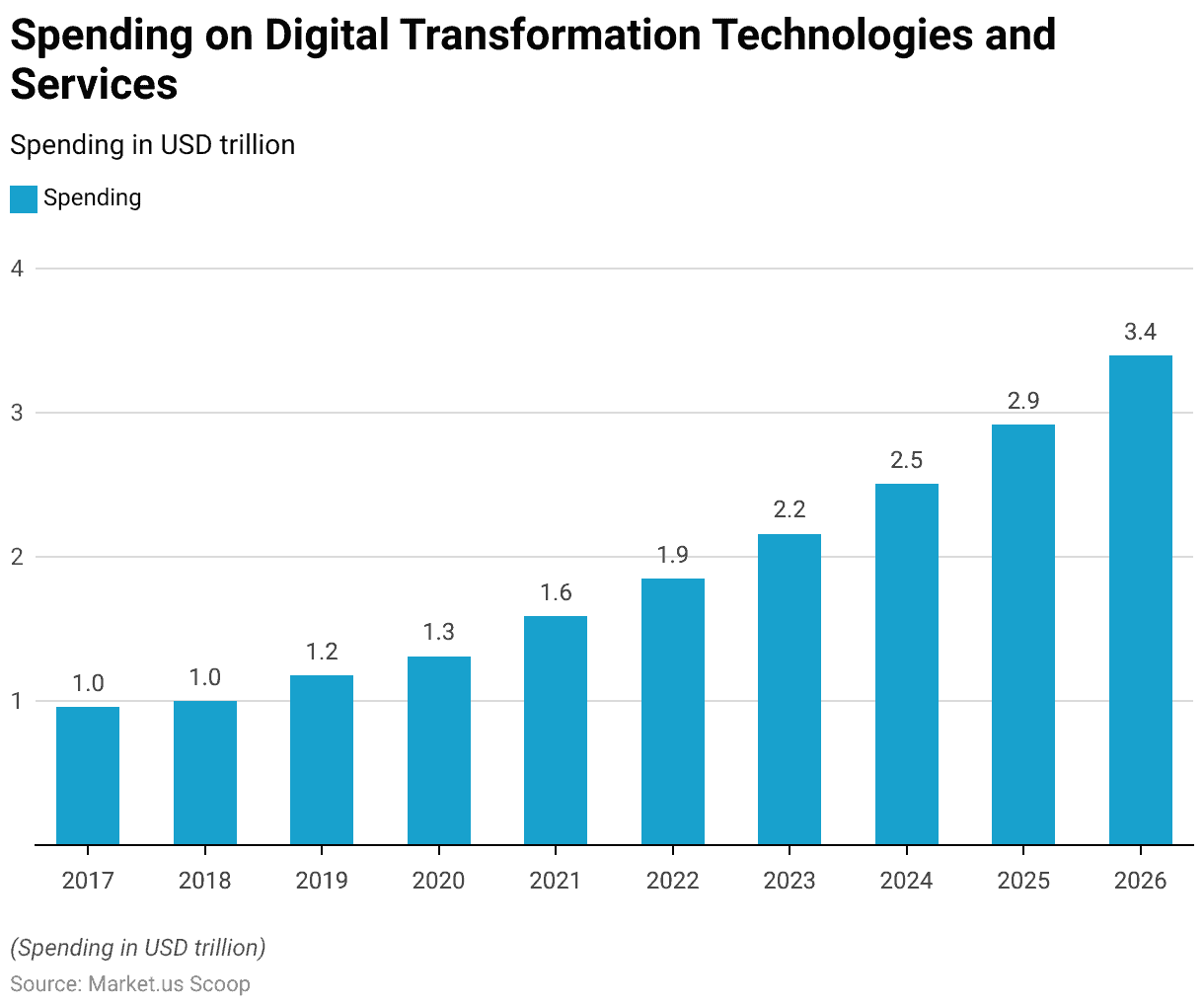
Benefits of Adopting a Digital Model
- The adoption of a digital model in business operations offers a spectrum of advantages, contributing to enhanced overall efficiency and competitiveness.
- Foremost among these benefits is the improvement of operational efficiency, garnering a significant 40% consensus among respondents.
- Meeting changing customer expectations closely follows, with 35%, emphasizing the pivotal role of digital transformation in aligning products and services with evolving consumer demands.
- Another notable advantage is the improvement in new product quality, acknowledged by 26%, demonstrating the positive impact of digital models on product development processes.
- The adoption of digital models also facilitates an increase in design reuse, identified by 25%, promoting resource optimization and streamlined workflows.
- Moreover, there is a recognition of the potential to reduce product development costs, with 24% citing this benefit, contributing to a more cost-effective and agile development cycle.
- The introduction of new revenue streams is identified as a valuable outcome, with 21% recognizing the capacity of digital models to unlock innovative avenues for generating income.
- Additionally, the adoption of digital models is acknowledged for its potential to reduce the cost of poor quality, as indicated by 14%, highlighting the importance of precision and quality control in digitalized processes.
- Finally, the improvement in first-pass yield is recognized by 5%, underlining the role of digital models in refining and optimizing production processes for greater efficiency.
- Collectively, these benefits underscore the transformative impact of adopting a digital model in business operations, driving improvements across various facets of organizational functioning.
(Source: Super office)
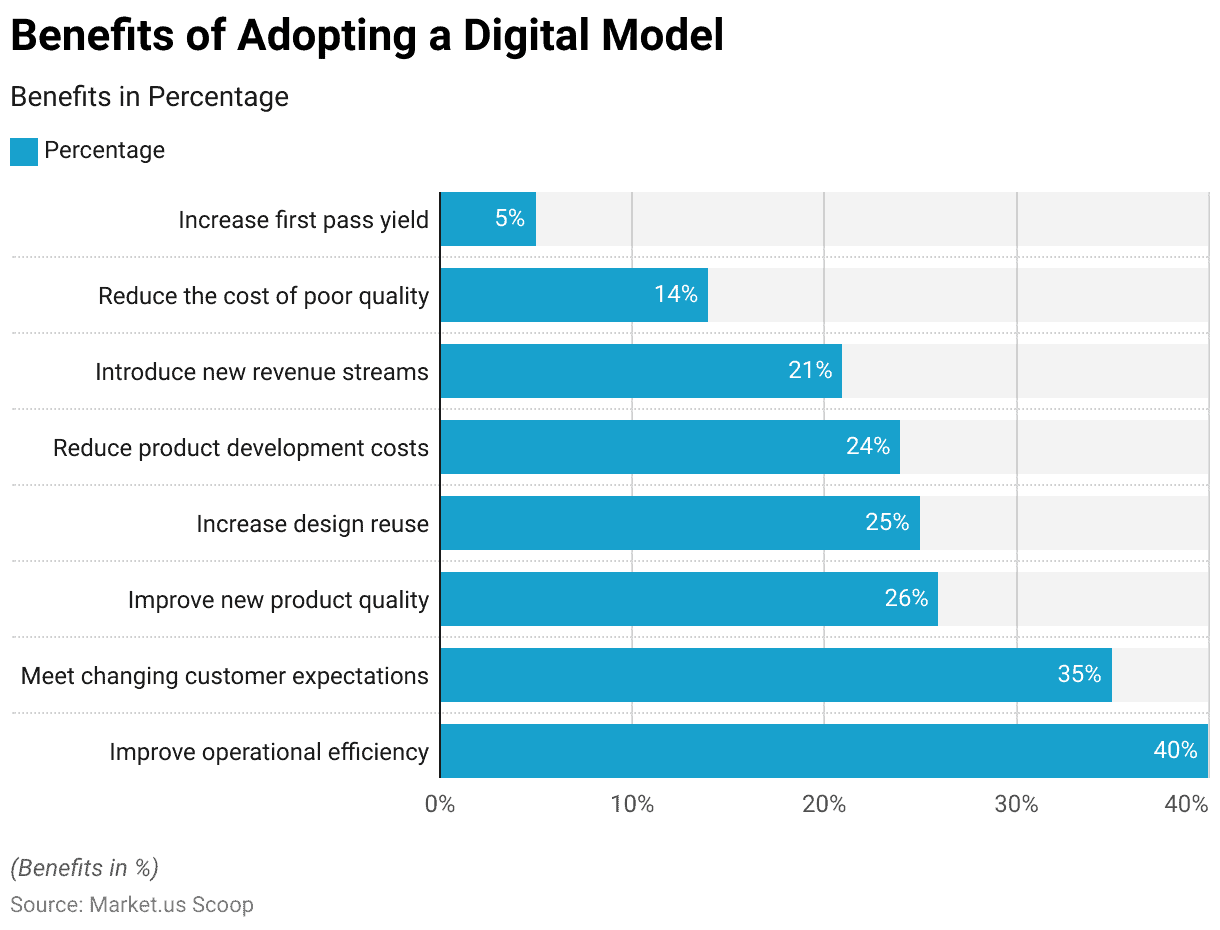
Digital Workplace Trends
- A majority of companies, totaling 64.5%, express confidence in their capacity to effectively adjust to technological disruptions.
- In terms of job creation, 67.8% of companies note that the impact of disruptions has been either neutral or positive.
- Among the surveyed companies, 37.3% report a net increase in job creation resulting from technological disruptions, while 31.3% acknowledge a negative impact on job creation.
- Overall, 50.4% of organizations maintain a positive outlook regarding the influence of technology disruption.
- However, there is a segment, comprising 20% of all departments, facing challenges in adapting to technological disruptions.
(Source: Futurum-2018)
Recent Developments
Acquisitions and Mergers:
- Citrix acquires Wrike: In 2023, Citrix acquired Wrike, a leading collaborative work management platform, for $2.25 billion. This acquisition aims to enhance Citrix’s digital workplace offerings by integrating project management tools and streamlining remote work collaboration.
- Microsoft acquires Ally.io: In early 2023, Microsoft acquired Ally.io, a leading OKR (Objectives and Key Results) platform, for $100 million. This acquisition is part of Microsoft’s strategy to integrate Ally.io’s performance management tools into its Viva employee experience platform, improving workforce alignment and productivity in digital work environments.
New Product Launches:
- Google Workspace introduces AI-powered Smart Canvas: In 2023, Google launched Smart Canvas, a new set of AI-powered collaboration tools within Google Workspace. Smart Canvas allows teams to work more seamlessly across documents, spreadsheets, and communication platforms, aiming to increase productivity by 20% in digital workplaces.
- Salesforce launches Slack Huddles: In late 2023, Salesforce introduced Slack Huddles, a feature that allows teams to hold informal audio discussions in real time. This tool aims to recreate spontaneous collaboration in physical offices, enhancing communication in the digital workplace.
Funding:
- Asana secures $150 million for workplace collaboration tools: In 2023, Asana, a leading work management platform, raised $150 million to expand its digital workplace tools. The funding will help enhance Asana’s AI-driven features and integrate with more enterprise systems, improving team productivity in hybrid work settings.
- Miro raises $400 million for digital whiteboard expansion: In mid-2023, Miro, a digital whiteboard platform, raised $400 million to expand its offerings for remote collaboration. The funds will be used to develop new features and integrations, positioning Miro as a key tool for virtual brainstorming and project management.
Technological Advancements:
- AI-driven workforce analytics: By 2025, 45% of digital workplace platforms will integrate AI for workforce analytics, providing real-time insights into employee performance, productivity trends, and work-life balance to help optimize operations.
- Virtual Reality (VR) in digital workplaces: The use of VR for remote collaboration is growing. By 2026, 30% of enterprises are expected to implement VR platforms for virtual meetings and immersive training experiences in digital workplace settings.
Conclusion
Digital Workplace Statistics – In summary, the digital workplace is evolving with increased technology adoption across industries, with revenue projected to grow from USD 33.0 billion in 2022 to an expected USD 234.0 billion in 2032, showcasing the widespread impact of digital solutions.
Companies prioritize digital transformation, cybersecurity, and cloud migration for competitiveness, using technology integration to boost efficiency and innovation.
With trillions invested in digital transformation, organizations aim for improved efficiency, customer satisfaction, and diversified revenue streams.
Despite positive sentiments on technology disruption, challenges persist, highlighting the ongoing need for adaptation in this dynamic digital era.
Overall, the digital workplace represents a changing landscape, shaping the future of work through technology, strategic initiatives, and adaptability.
FAQs
A digital workplace is a modern work environment that leverages digital technologies to enhance employee collaboration, communication, and productivity. It integrates various tools and technologies to create a more efficient and flexible working environment.
The key components of a digital workplace include collaboration tools, cloud-based infrastructure, mobility solutions, and technologies like artificial intelligence and data analytics. These elements aim to facilitate seamless communication, access to information, and efficient workflow.
A digital workplace brings several benefits to organizations, such as improved operational efficiency, enhanced collaboration, increased employee engagement, and the ability to adapt to changing work trends. It also fosters innovation and can lead to cost savings.
Digital workplace solutions are being adopted across various industries, including healthcare, finance, retail, and manufacturing. The versatility of these solutions allows organizations in different sectors to tailor them to their specific needs.
Digital transformation is the process of integrating digital technologies into all aspects of business operations, and it plays a crucial role in shaping the digital workplace. It involves reimagining processes, adopting new technologies, and fostering a culture of innovation to stay competitive in the digital age.
Discuss your needs with our analyst
Please share your requirements with more details so our analyst can check if they can solve your problem(s)



